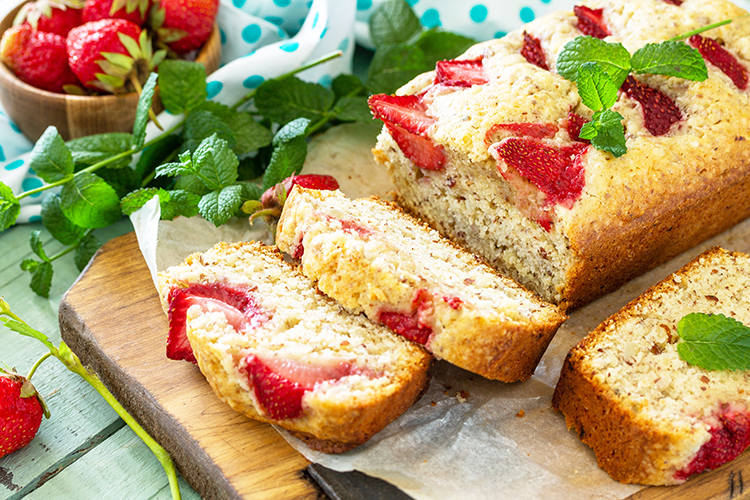Gluten-free bakery products continue to be in demand. Though first generation baked goods had superior taste and texture, they lacked nutritional enhancement. As a result, newer versions used new gluten-free ingredients such as plant-based proteins, enzymes, nutritional oils and fibers. Because of this, formulators managed new sets of challenges. Citri-Fi® citrus fiber is a multi-functional ingredient ideal for gluten-free formulating. This natural ingredients binds oil and water which provides moisture retention, binding, improved freshness, emulsification and freeze/thaw stability in a variety of baked goods.
Back in 2005 during my R&D days, gluten-free bakery became the next new hot wave for food formulators. Working in R&D meant you joined sensory panel evaluations or bakery cuttings. And at that time, my bakery team produced never ending rounds of gluten-free breads using a cocktail of starches, gums and gluten-free flours. The polarizing results teetered between a mouth full of sawdust to teeth encased with gummy dough. As a result, formulating with gluten-free ingredients reverted my bakery team to ground zero.
At that time, the goal was to create a gluten-free food that was edible and tasted good. That meant using gluten-free ingredients not typically found in a baker’s toolbox. However, over time, bakers churned out high quality acceptable gluten-free bakery products. Yet, today, gluten-free still faces a few challenges including lack of nutrition. Because formulators primarily focused on taste and texture, they used gluten-free ingredients consisting of lower amounts of vitamins, minerals, protein and fiber versus their gluten-containing counterparts. For instance, first generation formulations contained starches and food gums minus the fortification. Though the market found safe products to eat, they lacked the nutritious and wholesome diet.
However, today, the gluten-free category continues to thrive. Besides Celiac’s disease, gluten and wheat intolerances and allergies, other trendy diets such as paleo, keto and FODMAP spurred further demand for gluten-free products. At the same time, formulating evolved into a more sophisticated task. The toolbox expanded to equip formulators with a variety of plant-based proteins, enzymes, nutritional oils, fibers and formulating techniques. The revised ingredient toolbox and trendy diet fads also created new formulating challenges. Product developers ran into issues with binding, emulsification, moisture retention, crumb formation and structure. Yet, despite the nuisances, there is one gluten-free ingredient formulators needed to add to their gluten-free toolbox – citrus fiber.
Next Generation Gluten-free Ingredients
Citrus fiber, such as Citri-Fi, serves as an ideal functional fiber used in gluten-free formulating. However, not all citrus fibers are created the same. Some citrus fiber suppliers pull byproduct from their pectin extraction processes which at times limits their functionality due to their composition. On the other hand, citrus fibers like Citri-Fi, are upcycled materials created from byproduct of the citrus juicing process. As a result, this citrus fiber’s composition does not change. It remains how nature intended it to be. Citri-Fi consists of insoluble and soluble fiber in the form of pectin. The high concentration of intact native pectin gives this citrus fiber the multi-functionality which is key in gluten-free formulating.
Citrus Fiber's Multi-functionality at Work
Many gluten-free bakery formulations use ingredients that do not provide much viscosity. A popular work around is to use food gums or pregel starches. However, due to Citri-Fi citrus fiber’s fibrous composition, it contributes thickness when hydrated. As a result, this helps thicken up the dough, which typically is more like a batter when working with gluten-free ingredients, and makes handling easier. Formulators typically add Citri-Fi to the dry ingredients such as flour, salt and sugar first before combining with the liquids.
Another key benefit Citri-Fi provides is moisture retention. The citrus fiber’s fibrous matrix traps water and holds onto it at low usage levels (<1%). As a result, this improves the gluten-free breads freshness over time. And because many gluten-free products are typically frozen and slacked out later to minimize staling, Citri-Fi can bind the water and prevent it from migrating during the freeze/thaw process.
Because gluten-free falls under the non-allergenic umbrella, formulators are sometimes tasked to veer away from other allergenic ingredients such as egg, soy and dairy. As a result, they seek out natural emulsifiers to improve the crust and cell formation of the gluten-free bakery products. Citri-Fi citrus fiber binds oil and water in these type of systems. So, depending on the formulation, Citri-Fi, which is non-allergenic, can be used as a natural emulsifier in gluten-free bakery products such as breads, muffins and cakes.
Boosting Nutrition via Fiber
Lastly, as mentioned in the beginning, gluten-free products lack a solid nutritional profile. Using Citri-Fi citrus fiber helps contribute some dietary fiber to the nutritional panel. Though the fiber contribution is limited due to the lower usage level, this citrus fiber can be used with other plant-based fibers to help boost up the fiber content. This gluten-free ingredient’s labeling options include citrus fiber, dried citrus pulp or citrus flour which resonate well in the clean label and natural markets.
Please contact us to learn more about citrus fiber in gluten-free bakery products.



